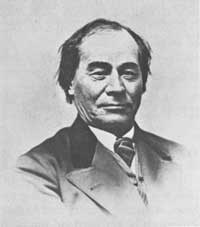Last updated: June 24, 2024
Article
Colorado: Bent's Old Fort Historic Site

National Park Service
Following the Louisiana Purchase of 1803, Americans began moving into the Rockies to take advantage of the trading opportunities across the western frontier. At the same time, the first wagons rolled along the Santa Fe Trail, which not only connected settlers to the new southwestern territories, but also served as an international highway for commerce between the United States and Mexico. As the Santa Fe Trail facilitated travel across the Southwest, the region saw an increase of traders seeking to make a profit from the commercial benefits of the trail. Among them were brothers Charles and William Bent and their business partner Ceran St. Vrain, who established the base for their trading company near the boundary between the United States and Mexico. Today, although the original structure is no longer standing, the reconstructed trading post at Bent’s Old Fort National Historic Site commemorates the historic role of the trading post during the exploration and settlement of the American Southwest.
Erected in 1833, Bent’s Fort, then called Fort William, was at a strategic location on the northern bank of the Arkansas River. Here the Bent, St. Vrain & Company could take advantage of the multiple trading opportunities that the Arkansas Valley offered. The post’s proximity to the Rockies drew in trappers to benefit from the beaver market; it also placed the Bent, St. Vrain & Company near the hunting grounds of the different Plains tribes, who demonstrated their willingness to trade with company. Among those seen trading at Bent’s Fort were the Arapaho, Kiowa, Navajo, and Southern Cheyenne, whose buffalo robes were highly sought. In addition to trading furs, the Plains Indians exchanged horses and mules for the Americans’ tobacco, axes, firearms, and other technological goods.
The company benefitted from trade with the Indians and also made a profit from the nation’s western migration. At the time, Bent’s Fort was the only place between Independence and Santa Fe where travelers could repair their wagons, refresh themselves, and replenish supplies. The fort was a colorful and vibrant place that welcomed all kinds of people regardless of their culture, race, or nationality. Included in the mix--whether they spoke English, Spanish, French or one of the dialects of the Indian languages--were white settlers, soldiers, slaves, traders, and American Indian tribes. Forty to sixty employees helped operate the successful trading post.
Although both the Bent brothers and Ceran St. Vrain managed the company, William Bent was the main administrator of Bent’s Fort. While his brother traveled between the post and St. Louis and St. Vrain ran the company’s stores in Taos and Santa Fe, William directed the Indian and trapping trade at Bent’s Fort. As an effective peacemaker who understood the Native American way of life (He married Owl Woman, a southern Cheyenne.), William was largely responsible for the company’s excellent reputation among the different Plains tribes. As a result, traders from Bent’s Fort were always welcome in Indian Territory, and by 1846 the fort itself had become the headquarters for the Upper Platte and Arkansas Indian Agency. In addition to serving as an agency for Indian-American relations, Bent’s Fort was also the staging area for military operations during the Mexican-American War (1846 to 1848).
Despite attaining a significant commercial, political, and military status during this period, Bent’s Fort was abandoned by the end of the Mexican-American war. The war led to the United States acquiring New Mexico, but it destroyed the company’s trading partnership with Mexico. At the same time, tensions were brewing between the American Indians and settlers as increasing numbers of emigrants and gold seekers moved further into Indian Territory. TThese problems and the death of Charles Bent in 1847 led William Bent and St. Vrain to attempt to sell the fort to the US Army. When this effort failed, William abandoned the site in August 1849, and in 1853 established Bent’s New Fort 40 miles down the Arkansas River.
Visitors can begin their tour by walking the ¼-mile trail to the fort’s main gate. A documentary entitled “Traders, Tribes and Travelers” brings the fort to life. A film entitled “Traders, Tribes and Travelers” conveys the story of the fort to life. Visitors can take either guided tours or a self-guided tours. Check the park website for a schedule of programs.
Although the original fort no longer sits on the prairies of the Arkansas Valley, old drawings, archeological findings, eye witness descriptions, and conjecture provided information to reconstruct Bent’s Old Fort. Built on the exact footprint of the original, the reconstructed trading post paints a picture of what it was like to live, work, trade, and visit Bent’s Fort when it was in operation. The two story reconstructed fort includes trade rooms, a council room used for peace talks between tribes, and blacksmith and carpenter shops. There are also reconstructed warehouses, where the company stored food during the winter, the cook’s room, dining room, kitchen, and the sleeping quarters.
Bent’s Old Fort National Historic Site, a unit of the National Park System and a National Historical Landmark, is located at 35110 Highway 194 East in La Junta, CO. There is an admission fee. For more information, visit the National Park Service Bent’s Old Fort National Historic Site website or call 719-383-5010.
Click for the National Register of Historic Places File: text and photos.
